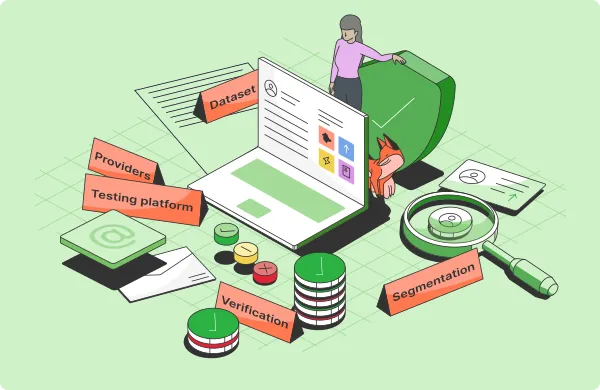TL;DR — Email Verification
- Email verification checks whether an address exists and can receive emails before you send.
- It helps you avoid bounces, spam traps, and risky mailboxes that damage sender reputation.
- Verifying lists improves deliverability, analytics accuracy, and overall campaign ROI.
- It’s fast, inexpensive, and essential for anyone sending cold emails, newsletters, or outreach at scale.
- Best practice: verify before first contact, at list capture, and regularly over time.
When you reach out to people outside your organization, verifying email addresses helps you prevent unnecessary risks.
Any time you send an email externally (and especially if it’s your first email to a given email address), things can go wrong:
- The email address you use may contain a typo or no longer exist.
- The domain might be inactive or misconfigured.
- The recipient’s server could reject your message.
- The address could belong to a spam trap or other risky mailbox.
- The failed delivery could hurt your sender reputation.
These issues translate to wasted time, lost opportunities, and even long-term deliverability issues for your entire organization.
Verifying email addresses with an email checker is how you mitigate these risks.
Email verification is a basic aspect of email hygiene for anyone sending pitches, cold emails, newsletters, or any other type of outbound email. It takes seconds, costs little, and prevents most deliverability issues before they occur.
When you verify email addresses before sending your emails, you can discard risky or invalid recipients and avoid the negative outcomes. To protect your mailbox, sales or marketing campaigns, and your entire business, you should include email verification whenever sending outbound emails.
What is email verification, anyway?
Email verification is the process of verifying whether an email address exists and is capable of receiving messages. It involves multiple checks from basic syntax validation to complex SMTP verification.
The output of email verification is a status for the verified email address:
✅ Valid: the email address exists, so your email is safe to send.
⚠️ Accept-all (sometimes referred to as catch-all or risky): the email address can’t be verified as valid or invalid with full confidence.
❌ Invalid: the email address doesn’t exist and your email will not reach the recipient.
Besides these fundamental checks, verification also helps you spot:
- Personal email addresses (e.g., name@gmail.com) to avoid using them in a professional context,
- Disposable email addresses (e.g., name@disposablemail.com). Disposable mailboxes may look valid at a first glance, but they’re typically used to bypass user authentication and are set up using specialized services to be temporarily active. Contacting them is risky, and they are sometimes set up with malicious intent.
While you can manually perform basic syntax and spelling checks, you need an email verification service if you want to properly verify email addresses—and especially if you have an entire list to verify. Email verifiers automate the process, returning a verification status for each verified email address.
For more, read our article on how email verifiers work.
How to choose a good email verification service
Not all email verifiers are the same. They differ in accuracy, pricing, and the additional features they offer.
When looking for an email verification solution, consider the following:
- Comprehensive and accurate checks: Your email verifier should perform all the critical verifications (syntax, domain, MX, SMTP, catch-all detection, disposable email filtering, etc.) with a high accuracy rate.
- Bulk and real-time capabilities: Look for a service that can handle large list uploads and offer an API to integrate into your workflow.
- Pricing model: When evaluating solutions, consider the cost per verification, pricing flexibility,
- Additional features: An email verifier with finding and sequencing capabilities included can drastically reduce your total spend. For example, when you find emails with Hunter, they come pre-verified which leads to direct savings.
For more, check our benchmark of the top 15 email verifiers.
Who is email verification for
If you’re ever sending emails to people you haven’t interacted with before, you definitely need email verification. A quick email check can save you the headache of dealing with bounces and removes the uncertainty of who did or didn’t receive your email.
The main benefits of email verification are:
- Better deliverability: When you verify email addresses before sending your pitch/cold email, you’ll get fewer bounces. Limiting bounces protects your sender reputation and helps future emails land in the inbox.
- Lower sending costs: Sending emails takes time. Verifying addresses before sending removes invalid ones, so you spend only on real recipients.
- Protection against blocklists and spam traps: Verification tools detect spam traps, honeypots, personal accounts, and other addresses that harm reputation or trigger blocks, helping you avoid getting blocklisted.
- More accurate analytics: If you’re sending emails at scale and your list contains bad data, your open and reply rates are distorted. Verification ensures your metrics reflect real recipients, leading to cleaner data and better decisions.
- Stronger brand reputation: Consistently emailing valid addresses signals professionalism, reduces complaint rates, and builds trust with both recipients and email service providers.
- Reduced costs for newsletters: If you’re running a newsletter, fake signups may inflate your costs drastically. Verifying your list removes bots from your mailing list, which means you’ll only send your emails to real people.
But email verification is even more important for anyone sending emails at scale:
- Marketers contacting users, customers, or subscribers on a regular basis,
- PR professionals pitching to websites, news outlets, and journalists,
- Founders or salespeople emailing potential sales prospects or business partners,
- Recruiters when reaching out to candidates or hiring managers.
For more, read our article on who really needs email verification.
When to verify email addresses
- Before reaching out for the first time: Make it a habit to verify any email address you’re contacting for the first time.
- When you’re preparing a big campaign: Before sending a big outbound campaign, consider verifying your entire list. This proactive step limits your bounce rate.
- Verify at point of capture: Whenever you collect emails (signup forms, lead magnets, event registrations), use real-time verification to prevent people from entering fake or mistyped addresses. This keeps bad data out from the start and saves time cleaning later.
- Regularly clean your lists (and verify emails in your CRM): Email addresses can become stale quickly – regular verification removes addresses that have become invalid over time.
Myths about email verification
Some of the most common misconceptions about email checkers include:
- Verification statuses change: an email that’s valid today may become invalid tomorrow.
- Verification doesn’t remove all bounces: invalid recipient address is not the only reason for email bounces.
- Verification isn’t only for large businesses: small businesses need to protect their email sender reputation, too, or they risk not being able to communicate efficiently via email.
To get a better understanding of what verification is and isn't read our article about email verification myths.
Pitfalls of email verification
Email verification keeps your sender reputation healthy and your emails reaching real people. But it’s easy to overlook or misuse. Here's a list of things to keep in mind:
- Re-verify your lists regularly; even valid addresses decay over time.
- Know the difference between valid and accept-all addresses to manage risk.
- Verify before sending, not after bounce-backs.
- Remember, verification isn’t a deliverability fix-all—reputation, warm-up, and volume still matter.
- Sync tools to avoid paying twice for the same verifications.
- Filter inactive contacts before bulk verification to save credits.
- Automate verification wherever possible to make it a habit.
For more, read about the pitfalls of email verification here.


